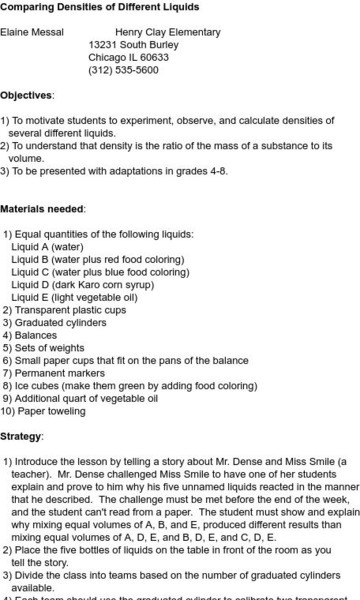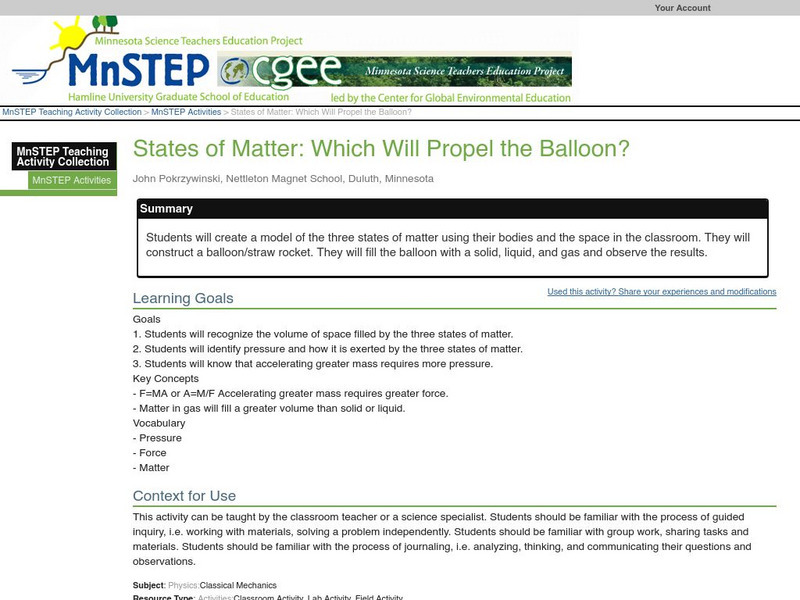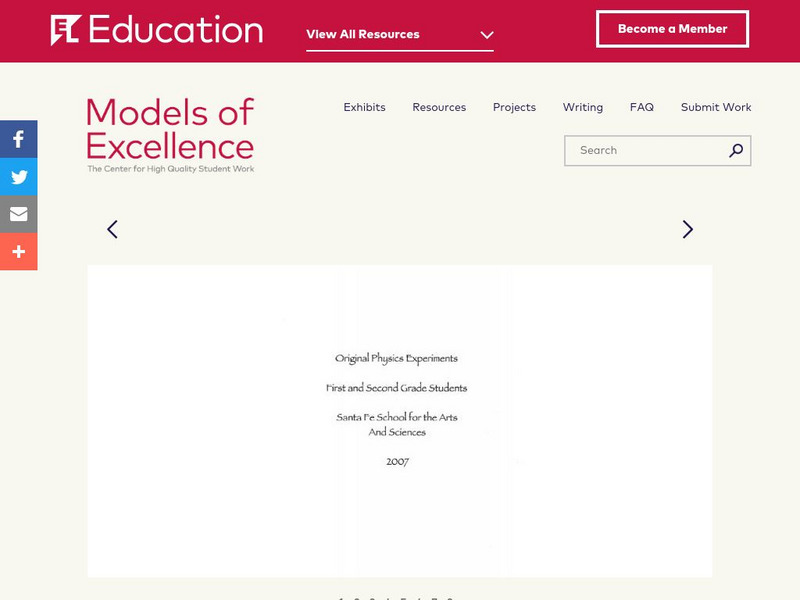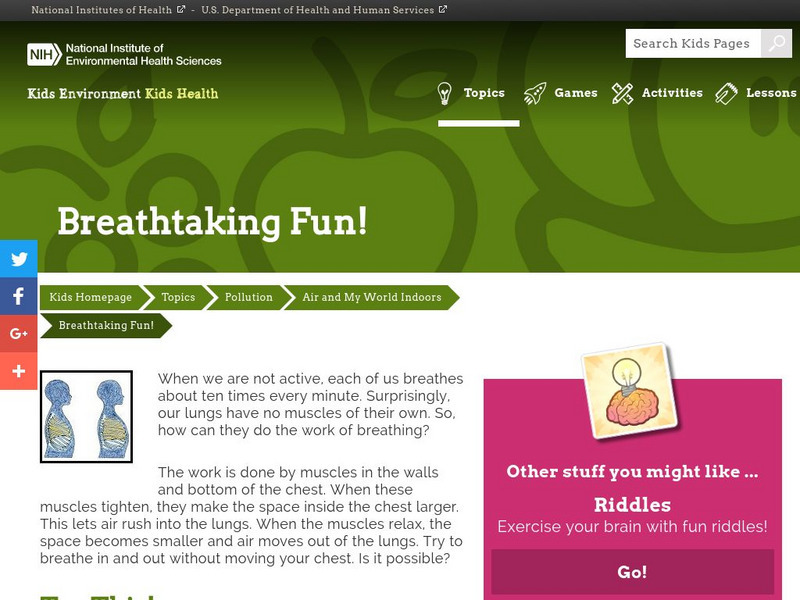Other
Port Discovery Children's Museum: Stem at Home: Bouncy Egg Experiment
Would you believe us if we told you we could make an egg bounce without breaking? Check out this experiment. It requires just three ingredients and five easy steps to learn how to bounce an egg.
Science and Mathematics Initiative for Learning Enhancement (SMILE)
Smile: Comparing Densities of Different Liquids
This lab experiment has students observe and compare the density of five different liquids while measuring mass and volume.
Science Education Resource Center at Carleton College
Serc: Mn Step: States of Matter: Which Will Propel the Balloon?
For this activity, students take part in a simulation of the three states of matter where they role play being molecules. They then create simple balloon rockets and must explain why a gas is the only state of matter that can cause the...
PBS
Pbs Kids: Dragonfly Tv: How Can You Sail in Outer Space?
Sailing is easy, if you have water. But can you use a sail where there isn't any water? PBS site invites you to come along with Sarina and Mia to explore if it is possible to use a sail in outer space.
Fundación Cientec
Cientec: Fisica
Different step by step experiments in Physics. It explorer concepts such as adhesion, pressure, weight, movement, balance, energy and more.
Fundación Cientec
Cientec: Perception
Simple step by step experiments that will allow students to learn about sight, smell and orientation.
Center of Science and Industry
Cosi Columbus: Bent Toward Science Refraction
Learn about refraction in this hands-on science experiment. Includes full list of materials, procedures, and scientific explanation of what happens when light moves from one material to another.
Center of Science and Industry
Cosi Columbus: Paper Cup Anemometer
Make your own anemometer like meteorologists use to measure the speed of wind. Includes full list of materials, procedures, and scientific explanation of what makes wind.
Center of Science and Industry
Cosi Columbus: Mighty Seeds
Learn about the process of germination in this hands-on science experiment. Includes full list of materials, procedures, and scientific explanation of why plants can survive in a variety of environments.
Center of Science and Industry
Cosi Columbus: Chocolate Lava
Learn about the two different types of lava in this hands-on science experiment that uses chocolate as lava. Includes full list of materials, procedures, and scientific explanation of the difference between the two.
Science Bob Pflugfelder
Science Bob: Homemade Slime!
Contains a procedure for creating slime -- a polymer formed by mixing water, borax, Elmer's glue, and food coloring. Following the procedure, the site contains a brief description of what polymers are.
Science Bob Pflugfelder
Science Bob: The Exploding Lunch Bag
This site contains a simple procedure for observing an acid-base neutralization reaction (baking soda and vinegar), in which the product, carbon dioxide, causes a zipped bag to explode.
Science Bob Pflugfelder
Science Bob: Make a Simple Duck Call!
Contains a procedure for using a plastic straw to create a device capable of producing a duck call when air is passed through. The site introduces the concept of vibration in sound production.
EL Education
El Education: Original Physics Experiments
Students ask questions about why things move the way they do and then design and carry out science experiments on the physics behind the movement. Students create lab reports to explain the steps of their process and to record...
National Institutes of Health
Niehs: Breathtaking Fun
Learn how your lungs help you breathe by making a model of the way your lungs work using a clear plastic bottle, scissors, and two medium-sized balloons.
Center of Science and Industry
Cosi Columbus: Boomerang
Students will make and fly boomerangs and discover that their spinning action is what makes them return to the thrower. Includes full list of materials, procedures, and scientific explanation of "gyroscopic precession".
Optical Society
Optical Society of America: Optics for Kids: Guiding Light Optical Fiber
This experiment demonstrates the concept of total internal reflection, using basic materials. Accompanied by a detailed explanation of what's happening, and links to articles on reflection and refraction.
Optical Society
Optical Society of America: Optics for Kids: Diffraction Between Wax Blocks
An activity to demonstrate how light behaves when encountering an obstacle, in this case, wax blocks placed in a ripple tank. Includes an explanation of the diffraction that occurs.
Optical Society
Optical Society of America: Optics for Kids: Interference in a Ripple Tank
An investigation, using a ripple tank, into how waves behave when they collide with each other. With an explanation of what is observed, and a link to an article on refraction.
Optical Society
Optical Society of America: Optics for Kids: Polarized Light (Pdf)
An investigation into how polarized light behaves, with instructions on how to make a polarizer using glass slides. With a link to an article explaining about polarized light. PDF (requires Adobe Reader).
Optical Society
Optical Society of America: Optics for Kids: Release the Rainbow
A simple activity to demonstrate how light separates into colors when it passes through water acting as a prism.
Optical Society
Optical Society of America: Optics for Kids: Black Is Black or Is It?
An experiment with a coffee filter and a marker to see what happens when water touches a black dot, or any other color. With links to several scientific, academic articles that explain what is happening.
Optical Society
Optical Society of America: Optics for Kids: Total Internal Reflection
An investigation into the total internal reflection of light, using a laser pointer. Accompanied by an explanation of what's happening, a discussion of Snell's Law, and links to additional information.
Optical Society
Optical Society of America: Optics for Kids: Shimmering Lenses
An experiment using Jell-O to create lenses, to see how light behaves with flat, concave, and convex lens surfaces. With an explanation of what is observed, and a link to an informative article on lenses.











